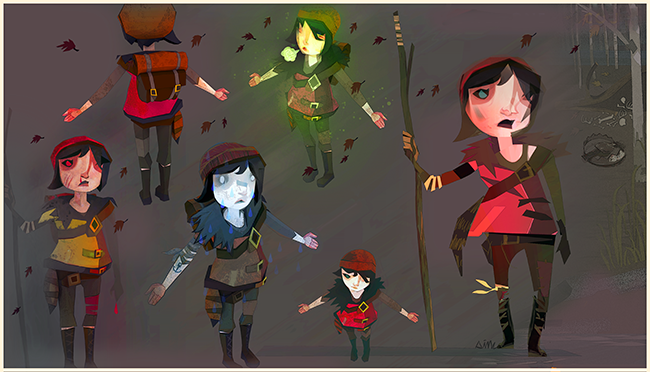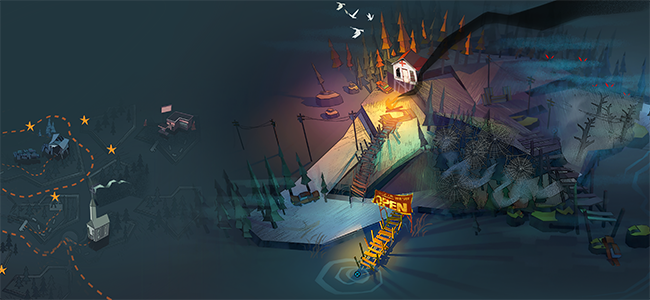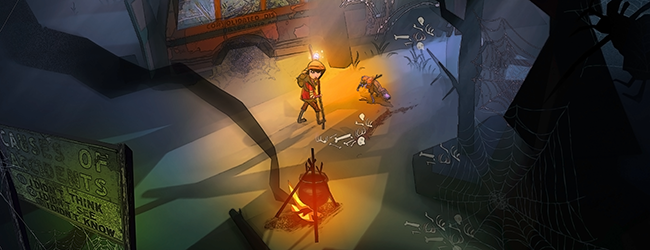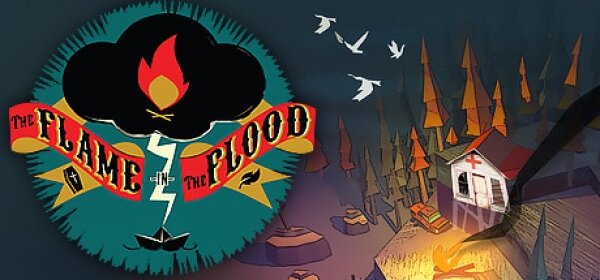Game - The Flame in the Flood
Release date - February 24th, 2016
Platforms - PC, Xbox One (reviewed)
Developer/Publisher - The Molasses Flood
The Flame in the Flood is a survival game that invokes a lot of questions, both personally and game related. When I first saw The Flame in the Flood was coming to Xbox One, my initial thought was "I can't wait to play this". Once I fired up our copy, the interest went from "I can't wait to play this" to "Why am I playing this?" to "I have to stop playing this" to "I'll play this again" to "I can't stop playing this ever".
You begin as a young girl named Scout accompanied by her dog Aesop. Yes, there's a dog named Aesop in a survivalist fable. You wake up alone in Camp Pinewood, an abandoned facility in the middle of nowheresville, as Aesop follows you. A short tutorial shows you that Scout is guided by five simple rules in her soon to be short lived life; Hunger, thirst, health, body temperature and energy. These all start at 100% and quickly decay over time. There are only two modes in the game, unfortunately, and there is no campaign. The first mode is your standard survivalist mode with checkpoints and decaying stats with ALLEGEDLY ample resources. The second mode is a permadeath mode with checkpoints scattered vastly apart and basically nonexistent. In addition, stats decay at a much quicker rate. This mode can't be beaten, at least not by I, and is quite simply an experiment in sadism and how much you can endure.
Scout herself offers an odd design. Her expression is nearly dead stonefaced and portrays that rough and tough look. It's tied in with her giant eyes and head which provide a counter punch to her expression that is much more vulnerable and child like. Ironically, this persists into gameplay and soundtrack as well. The Flame in the Flood is visually one stunning game. The atmosphere both while docked and on the river provide such full, saturated colors that not only provide a sense of depth and scale to the handdrawn design, but also invoke a sense of imagination in the player. A feeling of "manifest destiny" and the curiousity of what lies ahead is both a necessity and detriment at the same time. The flow of the water, rush of the waves and hue of the sun all combine for a pretty aesthetic experience.

As good as they are, they don't hold a candle to the music. Once you get on your raft after waking up in Camp Pinehood, the first "TWANG" of the acoustic guitar sets in. That's all you need. The soundtrack is so beautiful and captivating, that it reminded me of Achelous' daughters in Greek mythology. You may know them as the Sirens. In mythology, the Sirens were beautiful women who lured sailors to their death with their song by having them crash their ships amidst the rocks while entranced. Of course, the irony of being captivated by the game's alluring soundtrack and then crashing my raft into oblivion did not go unnoticed. We see what you did there Molasses Flood. Combined with the serene and comforting flow of the water, there always seems to be a sense of salvation lying ahead for you, no matter how small it may be.
The music also is incredibly beautiful, as noted. It does not over impose itself on the player, but still changes along with the game itself. The theme gets darker or more optomistic depending on Scout's health status. The manner in which Molasses Flood was able to combine the changes of the music into not only the physical progress of the game, but the emotional attachment to Scout, adds an overwhelming sense of immersion and enthusiam to the game. Lyrics and a harmonica are also added later on in the game, if you can survive long enough that is.
The Flame in the Flood captures the very essence of survival games. The thought of "Should i stop here and look for supplies, or keep going and hope I can find something better?" It's the very essence of humanity, in fact. Is what you have good enough, or do you risk it for the unknown and keep going despite not knowing how long until you can find more supplies, shelter, etc. It's what keeps us going in our own physical lives, and The Flame in the Flood intergrates it into the digital world in seamless fashion.
Up until now, you're probably thinking "Oh cool, a nice easy survival game. Maybe I'll check it out." Yeah, it's not easy. Not even close. But you SHOULD definitely check it out. You HAVE to keep moving in Flame in the Flood. This is not an option. Once you disembark at an island dock, you'll need to forage for food and supplies while avoiding the perils at hand. Wolves, snakes, bear, pigs and more. Those are just the tangible threats. And by the way, wolves are seriously OP. The intangibles include sepsis, starvation, dehydration, lacerations, broken bones and other environmentally suffered wounds. These can all be avoided, of course, if you have the right supplies. This is where the inate difficulty of Flame in the Flood comes in. While dying of hunger, you could craft a snare to catch a rabbit to eat. That is, of course, if you don't need to use the supplies required to craft it to make a bandage or a splint in order to mend a wound.

Yes, Flame in the Flood is a game, but the degree of separation between the manner in which your stats decline in game compared to how they would impact you in real life makes for one very difficult game to boot. More so than it should be, in fact. For example, most people can last several days without water and even longer without food, up to two weeks in fact sometimes. While playing, I found Scout continually running low on hunger or thirst. This occurred more than becoming afflicted by the elements. With the game's random and procedurally generated environments, it was made even tougher. Odd for this type of setup is how the game changes WHILE you play it. For example, at one point I was rafting down river and came across two possible points to disembark. One had a fire, the other did not. Since I was close to full health, I opted to dock at the location without a fire. I found few supplies, none of which I needed at the moment, and opted to leave for the fire as now my stats were diminished. Once I boarded back on my raft, I discovered the island that was there equipped with a fire was now gone due to the procedurally generated setup. With no other choice at my disposal, I set sail for the unknown hoping to find salvation ahead.
I can and do both appreciate and respect the premise of The Flame in the Flood: Take what's available to you and nothing more. After all, it IS what survival games are about. Can you make the difficult choice to put yourself at risk just a little bit longer so long as it MAY pay off in the end? It invokes not only a certain strategy, but also personal philosophy, but that strategy is removed by when islands disappear just because you visited another one first. Flame in the Flood has limited inventory with Scout maxed out at 12 items and Aesop can carry 6. If you can't use up multiple items to craft another, you'll need to decide whether to discard an item for the new one, or leave it and hope there is more in another location. This alone is a fine and normal strategy for survival games. On the other hand, I didn't appreciate the game changing as I played, because it removed all sense of gameplay strategy and skill, instead relying on the game's random procedural generator to hopefully give me what I needed. Too many times I died when I didn't need to because of this manner which became increasingly frustrating. In games of this type, it became quite unnecessary for islands themselves to disappear in game and detracted from the overall experience as any sense of strategy was therefore thrown to the wind. This caused pure luck to be the primary deciding factor in survival, opposed to player skill in game.
The UI is also rather confusing with the manner in which the menus are organized. If you are able to craft an item, it will automatically be highlighted when you enter a menu. You'll need to keep checking your inventory as the game does not notify you when you are able to craft a new item. Too often I found that some of the items I simply never got. Ever. One time I was able to survive for over 7 days. Just once. All of the others I lasted an average of 3-4 days max. At no point did I find a stitching kit or any item required to make a bandage. And yes, the game's items are procedurally generated too. When I tried to run away from a wolf by waving my fire at him, the same fire only attracted snakes. Since I had no way to craft any first aid items, Scout died a horrific death of broken bones, hypothermia, lacerations and poisoned by a snake. Yeah, it was that bad. After four islands of trying to find supplies, I unfortunately didn't find anything I could immediately use. As time went on, my stats depleted and I died. It's important to note that enemies are NOT victims of the procedurally generated system, only items. So, if you try to hide from a wolf by sleeping, he'll still be right there waiting when you wake up. Since you slept for several hours, you are also more hungry and thirsty then you were before your sleep, and therefore more susceptible to injury at the hands of the very same wolf. And remember, wolves are seriously OP.

There is a minor campaign to speak of in The Flame in the Flood. After all, it's a survival game. Plain and simple. The first mission is to use your radio and reach a high point for a better signal. I should note that I was unable to complete this mission. At first, I figured there was no way to complete the mission with only curiousity driving you forward. Fortunately, that isn't true but we were unable to complete this mission. You see, after confirming we were informed that the mission checkpoint is at the end of the 3rd region, approximately 12 miles down river. The longest we lasted was slightly over 7 days and we traversed just over 4 miles. So, basically not even close. We did, however, get to die. A LOT. 31 times in fact. Granted, we weren't that good, but we could have been better if the procedurally generated setup was organized slightly better.
Along with the captivating yet melancholic soundtrack, Flame in the Flood portrays the very essence of what it means for a survival game. The river is both your friend and, at the same time, a very dangerous foe. In fact, it teaches a valuable life lesson when survival is the only thing you need to worry about: Go with the flow. Paddling against the stream only uses energy and causes you to get tired faster. This also results in you dying faster. So don't do this. Often times you'll see a possible point to disembark, but unable to get there as the water rushes you past it. Go with the flow. There's always going to be another island up ahead. If you need an item and you have the items to craft it, make it. Go with the flow. In other words, take what the game gives you and don't look a gift horse in the mouth. Don't question the items that can help you survive just because you MAY find another item you'll need to survive later.
The Flame in the Flood also contains the most dangerous enemy ever placed in a video game; YOU. Your own curiousity. Your own judgement. Your own personal limitations. These impact you more in game than the enemies itself. Your own enthusiasm and optomism mustn't overshadow your realism. By the same token, the river is the savior of the game. It blends everything in the game together to where you're left with only the soft rush of the water in moments that I can only imagine were intended for self reflection. You improvise. You adapt. You try to survive.

I have absolutley no clue how The Flame in the Flood ends. To be honest, I am not sure if it even HAS an ending. In fact, there are achievements for surviving 200 miles and/or 40 days. Maybe the only thing that keeps you playing The Flame in the Flood is hope. Hope that there is something else out there and all is not lost. The hope that you keep in your head in real life that there is still some shred of joy out there and you simply need to find it. Maybe there is nothing out there at the end of the river. Maybe it' s just like life, where we take we can get while we're here and hope for the best. Who knows? What I do know is that you have to keep trying. Keep pushing forward and hope for the best, or give up and die. That's it. Plain and simple, just like life itself. Also just as in life, if you stop and listen to the beautiful music too long, like the soundtrack, it's all going to pass you by.
There are a lot of life lessons in The Flame in the Flood, and I wish that some of those weren't due to sheer luck with strategy being removed by the procedurally generated gameplay. On the other hand, it's a survival game that merits a try due to its sense of self reflection alone. Of the many survival games I've played, The Flame in the Flood most accurately depicts the very essence of survival while not overshadowing your personal immersion with useless themes. It's a survival game not only in game form, but one of personal reflection as well.
How will you survive?
BOTTOM LINE



